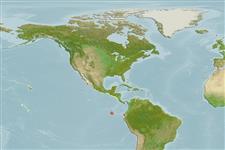Actinopterygii (ray-finned fishes) >
Perciformes (Perch-likes) >
Serranidae (Sea basses: groupers and fairy basslets) > Serraninae
Etymology: Cratinus: Latin, cratis, -is = grating, grille (Ref. 45335). More on author: Steindachner.
Environment / Climate / Range
Ecology
Marine; demersal; depth range 1 - 12 m (Ref. 55763). Tropical, preferred ?
Eastern Pacific: Ecuador to southern Peru. Also in the Eastern Central Pacific (Ref. 9342).
Size / Weight / Age
Maturity: Lm ? range ? - ? cm
Max length : 60.0 cm TL male/unsexed; (Ref. 55763); common length : 30.0 cm TL male/unsexed; (Ref. 55763)
Body elongate, not very deep, and little compressed; upper jaw lacking supramaxilla; teeth firmly placed; not folding back; lower branch of first gill arch with 12 to 15 gill rakers; 3 or 4 dorsal fin spines prolonged and filamentous; pelvic fins inserted slightly behind pectoral fins; anal fin with 7 soft rays; back light brown; belly pale; pectoral fins and prolonged dorsal spines reddish brown (Ref. 55763).
Found in mangrove areas as well as shallow inlets and bays (Ref. 5227).
Life cycle and mating behavior
Maturity | Reproduction | Spawning | Eggs | Fecundity | Larvae
CENAIM, 1992. A field guide to the edible fishes and shellfishes in coastal waters of Ecuador. Centro Nacional de Acuicultura e Investigaciones Marinas (CENAIM), Ecuador. 95 p. (Ref. 11035)
IUCN Red List Status (Ref. 115185)
CITES (Ref. 94142)
Not Evaluated
Threat to humans
Harmless
Human uses
Fisheries: commercial
More information
Common namesSynonymsMetabolismPredatorsEcotoxicologyReproductionMaturitySpawningFecundityEggsEgg development
ReferencesAquacultureAquaculture profileStrainsGeneticsAllele frequenciesHeritabilityDiseasesProcessingMass conversion
Tools
Special reports
Download XML
Internet sources
Estimates of some properties based on models
Phylogenetic diversity index (Ref.
82805): PD
50 = 1.0000 [Uniqueness, from 0.5 = low to 2.0 = high].
Bayesian length-weight: a=0.01096 (0.00528 - 0.02278), b=3.06 (2.89 - 3.23), in cm Total Length, based on LWR estimates for this (Sub)family-body shape (Ref.
93245).
Trophic Level (Ref.
69278): 4.2 ±0.73 se; Based on food items.
Resilience (Ref.
69278): Medium, minimum population doubling time 1.4 - 4.4 years (Preliminary K or Fecundity.).
Vulnerability (Ref.
59153): Moderate to high vulnerability (49 of 100) .
